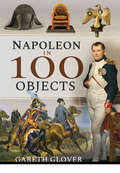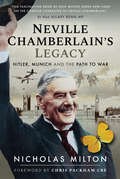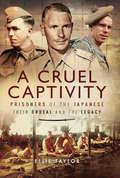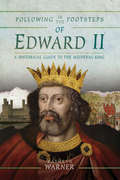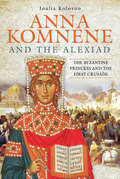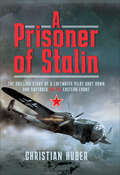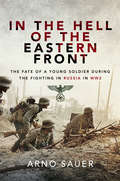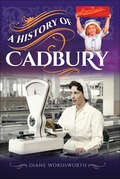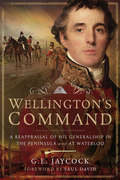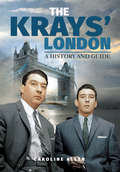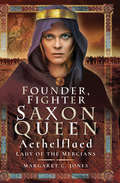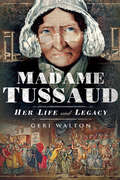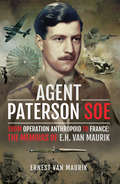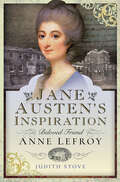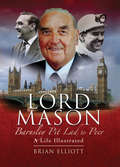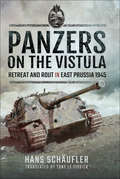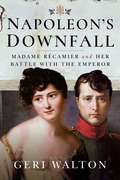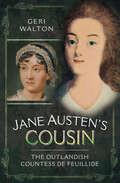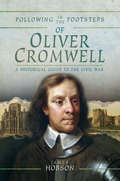- Table View
- List View
Napoleon in 100 Objects (In 100 Objects Ser.)
by Gareth Glover“Takes a look at the life of Napoleon Bonaparte through using 100 objects . . . an entertaining method of presenting a biography.” —Battles and Book ReviewsFor almost two decades, Napoleon Bonaparte was the most feared, and revered, man in Europe. At the height of his power, the land under his control stretched from the Baltic to the Mediterranean, and encompassed most of Western Europe.The story of how a young Corsican, who spoke French with a strange accent, became Emperor of the French at the age of just thirty-three is a remarkable one. The many fascinating objects brought together in this book detail not only Napoleon’s meteoric rise to power, but also his art of war and that magnificent fighting force, the Imperial Guard, which grew from a small personal bodyguard to the size of a small army. Some of his great battles, such as Marengo, Austerlitz, Jena and Wagram, are also explored, as is his exile and ultimate defeat at Waterloo. In this engaging and hugely informative book, the author takes us on a journey across Napoleonic Europe to discover the places, people and objects that tell the story of one man’s life. It is a story of one of the most turbulent eras in history, one that, to this day, still bears Bonaparte’s name. But his legacy lives on in the French legal and social systems and he remains as enigmatic a figure today as he did 200 years ago.“An amazing collection of objects that aid our understanding of the man who wanted to rule the world.” —Books Monthly
Neville Chamberlain's Legacy: Hitler, Munich and the Path to War
by Nicholas MiltonA biography reassessing the man whose name became a synonym for appeasement: &“An important read for anyone with an interest in the prelude to World War II.&” —The NYMAS Review Neville Chamberlain has gone down in history as the architect of appeasement, the prime minister who by sacrificing Czechoslovakia at Munich in September 1938 put Britain on an inevitable path to war. In this radical new appraisal of one of the most vilified politicians of the twentieth century, historian Nicholas Milton claims that by placating Hitler, Chamberlain not only reflected public opinion but also embraced the zeitgeist of the time. Chamberlain also bought Britain vital time to rearm when Hitler&’s military machine was at its zenith. It is with the hindsight of history that we understand Chamberlain&’s failure to ultimately prevent a war from happening. Yet by placing him within the context of his time, this fascinating new history provides a unique perspective into the lives and mindset of the people of Britain during the lead up to the Second World War. Never before have Chamberlain&’s letters been accessed to tell the story of his life and work. They shed new light on his complex character and enable us to consider Chamberlain the man, not just the statesman. His role as a pioneer of conservation is revealed, alongside his work in improving midwifery and championing the introduction of widows&’ pensions. Neville Chamberlain&’s Legacy is a reminder that there is often more to political figures than many a quick judgment allows.
Neville Chamberlain's Legacy: Hitler, Munich and the Path to War
by Nicholas MiltonA biography reassessing the man whose name became a synonym for appeasement: &“An important read for anyone with an interest in the prelude to World War II.&” —The NYMAS Review Neville Chamberlain has gone down in history as the architect of appeasement, the prime minister who by sacrificing Czechoslovakia at Munich in September 1938 put Britain on an inevitable path to war. In this radical new appraisal of one of the most vilified politicians of the twentieth century, historian Nicholas Milton claims that by placating Hitler, Chamberlain not only reflected public opinion but also embraced the zeitgeist of the time. Chamberlain also bought Britain vital time to rearm when Hitler&’s military machine was at its zenith. It is with the hindsight of history that we understand Chamberlain&’s failure to ultimately prevent a war from happening. Yet by placing him within the context of his time, this fascinating new history provides a unique perspective into the lives and mindset of the people of Britain during the lead up to the Second World War. Never before have Chamberlain&’s letters been accessed to tell the story of his life and work. They shed new light on his complex character and enable us to consider Chamberlain the man, not just the statesman. His role as a pioneer of conservation is revealed, alongside his work in improving midwifery and championing the introduction of widows&’ pensions. Neville Chamberlain&’s Legacy is a reminder that there is often more to political figures than many a quick judgment allows.
James Taylor: Cut Short (Artist Songbooks Ser.)
by James TaylorJames Taylor has an amazing story to tell, from battling through the junior ranks where he faced constant negativity about his height: to the pinnacle of his career as one of Englands top batsmen and elders in international cricket.Tragically, his career was cut short due to a serious heart condition which forced him to retire in 2016 at the age of 26. In his book, James will discuss his journey from a cricket loving boy to the international superstar he became.Revealing the inside story of his heart condition how it affected him personally and how he rebuilt his life and used his experience to help others. Jamess book will appeal not only to cricket fans, but also a wider audience as he tells his inspiring story of overcoming adversity.
A Cruel Captivity: Prisoners of the Japanese: Their Ordeal and The Legacy
by Ellie TaylorCarefully and sensitively researched, A Cruel Captivity describes the ordeals of, and lasting impact on, survivors of Japanese captivity.Differing in a number of respects from other moving POW accounts, this book covers the experiences of 22 servicemen from the Army, Royal Navy, RAF and volunteer forces who were held captive in numerous locations through South East Asia including Thailand, Burma, Hong Kong, the Spice Islands and Japan itself. Some had to endure the inhumane conditions during hazardous journeys on the hellships and all suffered appalling cruelty, starvation, disease and prolonged degradation on an epic scale. Yet these were the fortunate ones many thousands perished and their graves were unmarked.The book also examines the differing mental and physical effects that the prisoners captors cruel treatment had on them. The authors handling of the legacy of their experiences during the post-war years makes this moving book particularly important. For a full understanding of this dreadful aspect of the Second World War, A Cruel Captivity is a must-read.
Following in the Footsteps of Edward II: A Historical Guide to the Medieval King (Following In The Footsteps Ser.)
by Kathryn Warner&“Informed and informative . . . a meticulous example of outstanding scholarship, and an inherently fascinating read.&” —Midwest Book Review Edward II is famously one of England&’s most unsuccessful kings, as utterly different from his warlike father Edward I as any man possibly could be, and the first English king to suffer the fate of deposition. Highly unconventional, even eccentric, he was an intriguing personality, and his reign of nineteen and a half years, from 1307 to 1327, was a turbulent period of endless conflict and the king&’s infatuation with his male favorites, which ended when his own queen led an invasion of his kingdom. Following in the Footsteps of Edward II presents a new take on this most unconventional and puzzling of kings, from the magnificent Caernarfon Castle where he was born in 1284 shortly after his father conquered North Wales, to his favorite residences at King&’s Langley in Hertfordshire and Westminster, to the castle of Berkeley in Gloucestershire where he supposedly met his brutal death in September 1327, to Gloucester Cathedral, where his tomb and alabaster effigy still exist and are among the greatest glories surviving from medieval England.
Anna Komnene and the Alexiad: The Byzantine Princess and the First Crusade
by Ioulia Kolovou&“Kolovou . . . rescues Anna from the talons of misogynist historians and places her where she belongs as an extraordinary, but very human, woman.&” —Beating Tsundoku A woman of extraordinary education and intellect, Anna Komnene was the only Byzantine female historian and one of the first and foremost historians in medieval Europe. Yet few people know of her and her extraordinary story. Subsequent historians and scholars have skewed the picture of Anna as an intellectual princess and powerful author. She has been largely viewed as an angry, bitter old woman, who greedily wanted a throne that did not belong to her. After being exiled to a convent, she composed the Alexiad, the history of the First Crusade and the Byzantine Emperor, Alexios I Komnenos (1081-1118), her father. This book aims to present Anna Komnene—the fascinating woman, pioneer intellectual, and charismatic author—to the general public. Drawing on the latest academic research to reconstruct Anna&’s life, personality and work, it moves away from the myth of Anna the conspirator and &“power-hungry woman&” which has been unfairly built around her over centuries of misrepresentation. It places Anna Komnene in the context of her own time: the ancient Greek colony and medieval Eastern Roman empire, known as Byzantium, with the magnificent city of Constantinople at its heart. At the forefront of an epic clash between East and West, this was a world renowned for its dazzling wealth, mystery and power games. This was a world with Anna Komnene directly at the center.&“Well-written, well-researched, and an overall fascinating read . . . A brilliant addition to women&’s history.&” —Where There&’s Ink There&’s Paper
A Prisoner of Stalin: The Chilling Story of a Luftwaffe Pilot Shot Down and Captured on the Eastern Front
by Christian Huber Gerhard EhlertLeutnant Gerhard Ehlert was one of the few survivors of 2. Nachtaufklärungsstaffel, part of the Luftwaffe’s 6th Air Fleet, which operated on Eastern Front during the Second World War. Although he came from a family that spoke out against Hitler and the Nazi regime, he volunteered to join the Luftwaffe. He went on to undertake combat patrols under the most extreme circumstances. Facing hazardous weather conditions – often landing his aircraft ‘blind’ in heavy fog – and mountainous odds against Soviet air superiority, Ehlert completed twenty-two sorties before his Dornier Do 217M-1, coded K7+FK, was shot down on 14 June 1944. Despite strenuous efforts to escape the Soviets, along with his rear-gunner Feldwebel Wilhelm Burr, he was captured by the Red Army. What followed changed his life forever. Though interrogated repeatedly, Ehlert revealed nothing about his missions or duties. Then, during his transfer to a prisoner of war camp, he had to face a hostile crowd of Russian civilians who had suffered from the devastating effects of the Luftwaffe’s bombs. In the long journey eastwards across the bleak Russian steppes to the camp at Yelabuga, a town in the Republic of Tatarstan, Ehlert reflected on his early years and the road he took to the east and the horrifying situation he was in. But it was not the months he endured in the freezing prisoner of war camp which became his most haunting memory – it was when the war ended. The Russians announced that with peace came new rules. Now the prisoners must work and the food ration would be reduced. Their uniforms were removed, and all privileges of rank dismissed. To the Soviets they were no longer prisoners of war, they were mere criminals and were treated accordingly. Transferred to Bolshoy Bor in the north, day after day the men had to transport logs, even through the snow and ice of winter, with many of the prisoners dying of malnutrition and exposure. The Russians told them they were ‘to rebuild what they destroyed in the Soviet Union’. Ehlert’s suffering finally ended in 1949. He was able to return to his parental home, initially being treated as an unwelcome stranger. When he related his story to Christian Huber, Gerhard Ehlert was in his 90s, by then a happy father and grandfather, and undoubtedly a survivor.
In the Hell of the Eastern Front: The Fate of a Young Soldier During the Fighting in Russia in WW2
by Arno SauerA Nazi infantryman recalls the horrors of combat against the Soviet Union in this WWII memoir as told to his son.Friedrich “Fritz” Sauer was posted to the Eastern Front in 1942. A soldier in the 132nd Infantry Division, he was deployed in Hitler’s grand invasion of Russia. But instead of the swift knockout blow the Germans had anticipated, Operation Barbarossa ground on for almost four years. Sent first to the Crimea and then the region around Leningrad, Fritz experienced horrors of all kinds. In this memoir, Fritz recalls losing his best friend to a sniper, rescuing the body of a fallen comrade from No Man’s Land, enduring Soviet tank assaults, and his own wounding during a counterattack. Fritz was later transferred to a tank assault regiment where, on a mission to contact another unit, he lost his way in the snow. After sheltering with a farmer’s family, Fritz headed west to flee the advancing Red Army. His subsequent journey home took many twists and turns.
A History of Cadbury
by Diane WordsworthWhen John Cadbury came to Birmingham in 1824, he sold tea, coffee and drinking chocolate in a small shop on Bull Street. Drinking chocolate was considered a healthy alternative to alcohol, something Cadbury, a Quaker, was keen to encourage.In 1879, the Cadburys moved to Bournville and created their factory in a garden an unprecedented move. It is now ironic that todays Bournville is surrounded by that urban sprawl the Cadburys were so keen to get away from.This book looks at some of the social impact this company has had since its inception, both on the chocolate and cocoa business in general and on the community at large, both within and without the firm of Cadbury.In 2024, Cadbury's will be celebrating 200 years of the first store opening. This is the story of how the company began, how it grew, and how they diversified in order to survive.
Sam Quek: Hope and a Hockey Stick
by Sam QuekSam Quek is mainly known for her starring role in the 2016 Olympic gold medal winning hockey team. This was the first time a British ladies team had won gold, but what is much less known is that Sams rise to the top of her spot was far from easy.Sam missed out on being part of Team GB at the London 2012 Olympics but competed for England at the 2013 EuroHockey tournament and 2014 Commonwealth Games, which she won silver medals. She won the gold at the 2016 Rio Olympics after the GB hockey team beat the Netherlands on penalties.How Sam overcame the bitter disappointment of being overlooked for the two previous Olympics and ensured that she wouldnt miss out again are revealed here for the first time. She also tells of her tough childhood and her battle to reach the heights that she has.She then went on to further fame by appearing in Im a Celebrity where she proved to be hugely popular with the viewing public, eventually finishing fourth.Sam now presents a variety of sports for TV, including men and womens football, NFL and hockey. She has been signed up to be the main presenter for the womens World Hockey Championships in 2018, held in August.She is hugely popular on social media with thousands of followers on twitter and instagram. Sam also has some very strong views on how women are portrayed in sport and their treatment by both coaches and the media. This is a hugely topical subject at the moment and promises to remain so for some time.
Wellington's Command: A Reappraisal of His Generalship in the Peninsula and at Waterloo
by George E. JaycockA military historian assesses the leadership style of the man who defeated Napoleon.The Duke of Wellington’s victory at the Battle of Waterloo cemented his reputation as a great general, and much subsequent writing on his career has taken an uncritical, sometimes chauvinistic view of his talents. Little has been published that fully pins down the reality of Wellington’s leadership, clearly identifying his weaknesses as well as his strengths.George E. Jaycock, in this perceptive and thought-provoking reassessment, does not aim to undermine Wellington’s achievements, but to provide a more nuanced perspective. He clarifies some simple but fundamental truths regarding his leadership and his performance as a commander.Through an in-depth study of his actions over the war years of 1808 to 1815, the author reassesses Wellington’s effectiveness as a commander, the competence of his subordinates, and the qualities of the troops he led. His study gives a fascinating insight into Wellington’s career and abilities. Wellington’s Command is absorbing reading for both military historians and those with an interest in the Napoleonic period.
The Krays' London: A History and Guide
by Caroline AllenA true crime travel guide to the haunts and hangouts of the most notorious gangsters of London&’s East End. There are many conflicting stories about who Ronnie and Reggie Kray were. Films depicting their lives have made the public vilify them, adore them and even admire them. This guidebook will dig a little deeper into the places they spent their time. Many of the places are renowned as the stomping grounds of the devious duo, but there are one or two exclusives that are not yet covered anywhere else, including the untold story of their lifelong hairdresser. Chapter by chapter, a map of their lives will reveal itself, making this the perfect read for anybody around the world interested in London&’s gangster scene. &“I remember going home from a cinema visit to London in the early 1960s with police sirens all over the place as we went through the East End. I remember the newspaper reports of the time, and wondering how the police could allow such people to control the East End to such an extent, and to apparently countenance the horrors this evil gang inflicted on their own and their enemies. It was a horrendous time to be alive in the East End of London, and Caroline&’s superb book brings it all back to life.&” —Books Monthly
The Krays' London: A History and Guide
by Caroline AllenA true crime travel guide to the haunts and hangouts of the most notorious gangsters of London&’s East End. There are many conflicting stories about who Ronnie and Reggie Kray were. Films depicting their lives have made the public vilify them, adore them and even admire them. This guidebook will dig a little deeper into the places they spent their time. Many of the places are renowned as the stomping grounds of the devious duo, but there are one or two exclusives that are not yet covered anywhere else, including the untold story of their lifelong hairdresser. Chapter by chapter, a map of their lives will reveal itself, making this the perfect read for anybody around the world interested in London&’s gangster scene. &“I remember going home from a cinema visit to London in the early 1960s with police sirens all over the place as we went through the East End. I remember the newspaper reports of the time, and wondering how the police could allow such people to control the East End to such an extent, and to apparently countenance the horrors this evil gang inflicted on their own and their enemies. It was a horrendous time to be alive in the East End of London, and Caroline&’s superb book brings it all back to life.&” —Books Monthly
Founder, Fighter, Saxon Queen: Aethelflaed, Lady of the Mercians
by Margaret C. JonesThe story of the daughter of Alfred the Great, who fought against Viking invaders and ruled a kingdom in the tenth century. Alfred the Great’s daughter defied all expectations of a well-bred Saxon princess. The first Saxon woman ever to rule a kingdom, Aethelflaed, Lady of the Mercians, led her army in battle against Viking invaders. She further broke with convention by arranging for her daughter to succeed her on the throne of Mercia. To protect her people and enable her kingdom in the Midlands to prosper, Aethelflaed rebuilt Chester and Gloucester, and built seven entirely new English towns. In so doing she helped shape our world today. This book brings Aethelflaed’s world to life, from her childhood in time of war to her remarkable work as ruler of Mercia. The final chapter traces her legend, from medieval paintings to novels and contemporary art, illustrating the impact of a legacy that continues to be felt to this day.
Madame Tussaud: Her Life and Legacy
by Geri WaltonA &“meticulously researched and deftly written biography&” of the woman behind the famed wax museums, and their origins in the era of the French Revolution (Midwest Book Review). Madame Marie Tussaud is known worldwide for the chain of wax museums she started over two hundred years ago. Less known is that her original wax models were often of the famous and infamous people she personally knew during and after the French Revolution. These were people like Voltaire, Robespierre, and Napoleon—people who changed the world. Even more, the wax figures were depicted in scenes drawn from the horrors she experienced during the reign of terror in Paris during her early adult years. This book shows how the traumatic and cataclysmic experiences of Madame Tussaud&’s early life became part of her legacy. She created a succession of scenes in wax, telling events as she personally experienced them. Her wax sculptures were visceral. She made them herself, at times from the living person&’s head and at other times from the recently guillotined head of a former houseguest. As a result, people were drawn to her wax displays because they were the most intense way of experiencing those events themselves. This is the story not only of a unique artist, but of how one of history&’s bloodiest events influenced her life and work.
Agent Paterson SOE: From Operation Anthropoid to France: The Memoirs of E.H. van Maurik
by Ernest van MaurikErnest Van Maurik, known to all simply as Van, joined the illustrious Artists Rifles regiment in the Territorial Army in 1936, but when war broke out he was commissioned into the Wiltshire Regiment. In the summer of 1940 the regiment was posted at Folkestone to defend the South Coast in the event of an invasion, during which time he undertook a course at Hythe Small Arms School and found himself involved with the SOE, the Special Operations Executive.This led to him to Scotland, first to the Commando Training School at Lochailort and then to Arisaig, where he became responsible for helping organise resistance to the Nazi regime in occupied countries. This involved the training of prospective agents in small arms, demolition and other special forces activities. At this time, he helped train a number of Czech soldiers who went on to participate in Operation Anthropoid, the assassination of SS-Obergruppenfhrer Reinhard Heydrich in Prague.Van was then transferred to the SOEs headquarters in Baker Street, London. There he was to work for notable figures such as Maurice Buckmaster and General Colin Gubbins. He also got to know a number of individuals who were to become famous agents, people such as Peter Churchill, Odette and Yeo-Thomas (The White Rabbit). His main work was to get agents both in and out of Occupied France but then it was his turn to go into the field.Van was initially sent to Malta to help with the dropping of agents into Yugoslavia. His next mission was to Switzerland via Occupied France to assist SOE agents in France and also deal with couriers from F Section SOE who used Switzerland as a channel for communicating with London.After many adventures, Van reached Switzerland where he carried out his task until the end of the war in Europe. He then was involved in assisting the investigation into the fate of the many SOE agents who had been captured by the Germans and were still missing.
Jane Austen's Inspiration: Beloved Friend Anne Lefroy
by Judith StoveAn insightful portrait of Austen’s friend and fellow writer Anne Lefroy and the society that surrounded these two literary women.In this insightful new biography of Anne Lefroy, Judy Stove investigates the life of a writer who had a direct and undeniable influence on the life and works of Jane Austen. Jane shared some of her earliest writings with Anne, who became a devoted confidant; it is believed that their friendship was an essential component in their creativity. As a published female writer, Anne was an immense source of inspiration to Jane as she developed her own talents.Judy Stove, a member of the Jane Austen Society of Australia, brings a wealth of insight to this illuminating history of a literary friendship. She has uncovered fascinating snippets of information relating to Anne Lefroy’s circle, and her book addresses developments across a period of great social and political change. Setting Lefroy’s life in context, she looks at the war against Napoleon and illustrates evolutions in healthcare as well as changes in religious beliefs and practices that shaped the world of these remarkable women.
Lord Mason, Barnsley Pitlad to Peer: A Life Illustrated
by Brian ElliottRoy Mason swapped the colliery for Westminster when elected MP for Barnsley in 1953. He went on to become one of the leading figures in the Labour Party during the 1960s and 1970s, holding a number of prestigious offices including Defence Secretary from 1974 and Secretary of State for Northern Ireland from 1976. This photographic biography presents images from Mason's own archive charting his personal and political life from the Yorkshire pits to the House of Lords.
Panzers on the Vistula: Retreat and Rout in East Prussia 1945
by Hans SchäuflerThis WWII memoir of a Nazi officer is one of the most revealing firsthand accounts of the German retreat on the Eastern Front. A second lieutenant of the 4th Panzer division, Hans Schäufler commanded a Jagdpanther tank destroyer in rearguard actions against the Red Army in East Prussia in 1945. Then, as an infantryman, he took part in the doomed defense of Danzig before escaping across the Baltic in a small boat. His personal story offers a rare glimpse into the chaos and suffering endured by tens thousands of soldiers and civilians during the collapse of the Third Reich in the east. Along with vivid descriptions of the appalling conditions in Danzig and the fear and panic that gripped the city, Schäufler&’s account provides valuable insight into the German army&’s tactics as they fell back before the Soviet advance. While acute shortages of men, equipment, ammunition and fuel crippled the defense, the soldiers went on fighting for a lost cause in the face of certain defeat.
Ashley Jackson: An Artist's Life
by Chris BondAshley Jackson has had an extremely distinctive and illustrious life in the world of art. Since opening his first gallery back in 1963, he has become one of the country's leading and most successful landscape watercolorists. His unique evocative and distinctive paintings of brooding moorlands have become synonymous with Yorkshire, and more particular the moors above and around his Gallery situated in the heart of the Pennines, Holmfirth. His works have been exhibited worldwide, and adorn the walls of many successful and famous people, from politicians to actors, from Tsars to Princes. Ashley was honored when former US President, Bill Clinton, an avid art collector, was presented with an original watercolor. Ashley, throughout his career, has always been an ambassador for the arts. He has strived through his life to encourage people not just to take up art, but to appreciate the beauty of the landscape around us. His exhibitions have included "Ashley Jackson One Man Exhibition" at Patchings Artfarm, Calverton Notts in 2003 and "Ashley Jackson's Yorkshire Moors—a love affair"—Victoria Quarter, Leeds in 2002. He has also held exhibitions in New York, Chicago and Milan. His awards include the 2006 Life Time Achievement Award from Yorkshire Awards, and the 2007 Life Time Achievement Award from the Huddersfield Examiner. He is the present day Ambassador for Northernart. The local artist has done extensive charity work in the past and is part of the Prince's Trust.
Napoleon's Downfall: Madame Récamier and Her Battle with the Emperor
by Geri WaltonAn account of the wealthy socialite who opposed the French emperor and found herself exiled from Paris—from the author of Marie Antoinette’s Confidante.Napoleon Bonaparte and Juliette Récamier were both highly influential and well-known in France, yet they were often at odds with each other. Their story played out on the European stage during a period of political upheaval and new political ideas. Napoleon gained power in the aftermath of the French Revolution, and he would go from spectacular victories to dismal failure. His defeat in the early nineteenth century would result in Europe acquiring new national borders and with that Britain, Russia, and the United States would gain greater international influence.Juliette, on the other hand, wielded her own power. Because of the tumultuous French Revolution, noble and aristocratic landowners were being replaced by a new wealthy class in the private sector. Juliette and her husband were among the beneficiaries of this growing affluence and influence, and her power came from her newfound position in society.Juliette also viewed life differently than Napoleon. She saw life from the standpoint of a wealthy socialite whereas Napoleon’s desires were always shaded by his military experiences and his meteoric rise to power.Along the way, Juliette would have to face the testy Emperor, and she would find that his own brother would fall for her. Even some of Napoleon’s greatest enemies would woo her. “A fascinating look at two of the French Revolution’s most amazing and engaging characters, Napoleon Bonaparte and Juliette Récamier, both of whom wielded enormous power in a most turbulent time.” —Books Monthly
Napoleon's Downfall: Madame Récamier and Her Battle with the Emperor
by Geri WaltonAn account of the wealthy socialite who opposed the French emperor and found herself exiled from Paris—from the author of Marie Antoinette’s Confidante.Napoleon Bonaparte and Juliette Récamier were both highly influential and well-known in France, yet they were often at odds with each other. Their story played out on the European stage during a period of political upheaval and new political ideas. Napoleon gained power in the aftermath of the French Revolution, and he would go from spectacular victories to dismal failure. His defeat in the early nineteenth century would result in Europe acquiring new national borders and with that Britain, Russia, and the United States would gain greater international influence.Juliette, on the other hand, wielded her own power. Because of the tumultuous French Revolution, noble and aristocratic landowners were being replaced by a new wealthy class in the private sector. Juliette and her husband were among the beneficiaries of this growing affluence and influence, and her power came from her newfound position in society.Juliette also viewed life differently than Napoleon. She saw life from the standpoint of a wealthy socialite whereas Napoleon’s desires were always shaded by his military experiences and his meteoric rise to power.Along the way, Juliette would have to face the testy Emperor, and she would find that his own brother would fall for her. Even some of Napoleon’s greatest enemies would woo her. “A fascinating look at two of the French Revolution’s most amazing and engaging characters, Napoleon Bonaparte and Juliette Récamier, both of whom wielded enormous power in a most turbulent time.” —Books Monthly
Jane Austen's Cousin: The Outlandish Countess de Feuillide
by Geri WaltonEliza de Feuillide seemed fascinating and outlandish to her cousins in rural eighteen century England. When she visited their village, her appearance was electrifying. She was an attractive, accomplished French countess with a vivacious personality who inspired their imaginations and regaled them with stories of life in London and Paris where she hobnobbed with French nobility and wore the latest fashions. One of these impressionable younger cousins would find Eliza’s stories so fascinating that she would incorporate elements of Eliza’s life into some of the most famous novels in English literature. This cousin was Jane Austen. Yet Eliza’s life was not as glamorous as Jane or her Austen cousins might have thought. She faced many tragedies in her life that wealth and social class could not protect her against. She was also forced to adapt and reexamine her priorities in a way that would dramatically change her life choices and result in a more sedate lifestyle. Read about the perseverance and courage of the real person behind several fictional characters in Jane Austen’s writings and novels and the deeper connection Eliza had to the Austen family.
Following in the Footsteps of Oliver Cromwell: A Historical Guide to the Civil War (Following In The Footsteps Ser.)
by James HobsonA unique biography of the military commander and politician who remains one of Britain&’s most controversial figures centuries after his death. One of the most important figures in British history, Oliver Cromwell was both soldier and politician and the only non-Royal ruler of Britain in a thousand years. His actions and ideas still have political and social consequences today, and his legacy still divides people. Love him or loathe him, Cromwell still matters. This book is a history of his life through the places in Britain and Ireland where he lived, visited, ruled, or fought. Following in the Footsteps of Oliver Cromwell begins in Huntingdon in 1599, with the respectable but unimportant Cromwell family living under the shadow of richer relatives. Civil War and Cromwell&’s controversial successes at Marston Moor, Naseby, Basing House, and Worcester transform him into the most powerful person in Britain, saving him from obscurity and moving him from a modest house in Ely to Hampton Court Palace. Cromwell is involved in the execution of King Charles I outside the Banqueting House, his own coronation in Westminster Hall, and bloody slaughter in Ireland. Even his death in 1658 does not end the controversy—as his enemies take revenge on his corpse and the debate about his legacy begins.
